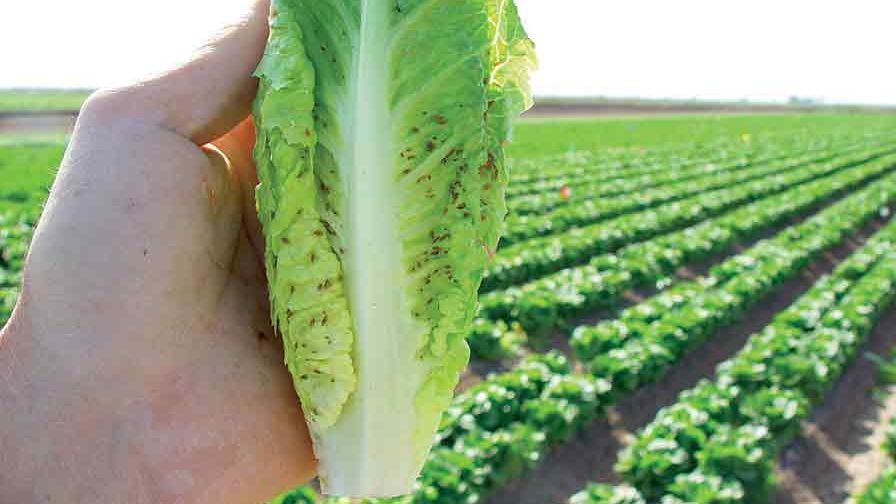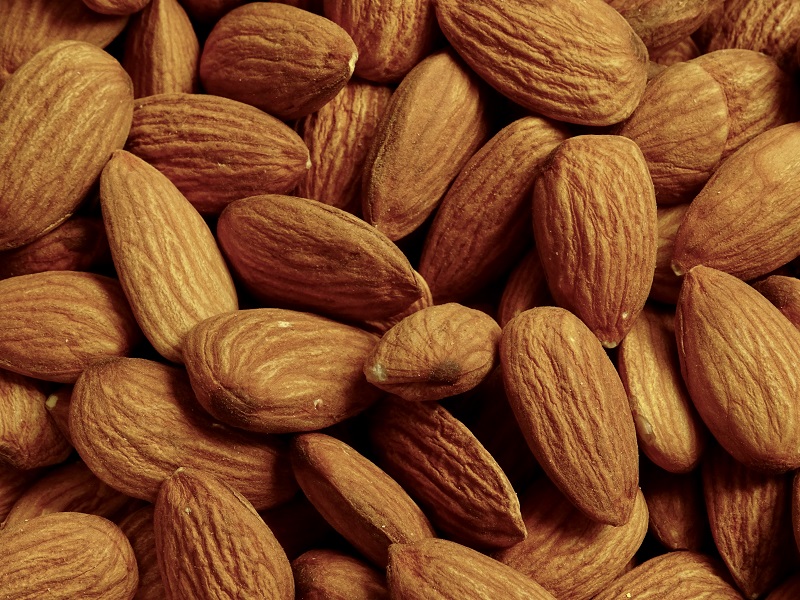Desert Vegetable Growers Have a Lot of Insecticide Choices

Romain heart contaminated with aphids.
Photo by John Palumbo
Until the 1990s, growers had a hard time delivering safe, high-quality, and marketable produce. That’s because there were only four classes of insecticide available. Today, you have 20 classes to choose from.
What’s Different Today?
Compared to the older organophosphates and carbamates, many new insecticides exploit alternative nerve receptor sites (neuro-muscular), novel physiological processes (insect growth and development), and other key biochemical functions (energy metabolism) specific to insects. As a result, they’re Integrated Pest Management compatible and inherently less toxic, including to non-target organisms (birds, fish, and plants), and have low potential for groundwater contamination, as well.
Because of their low mammalian toxicity, they have a short re-entry (four to 12 hours) and pre-harvest intervals (one to three days) that are less disruptive to labor and harvest activities.
Routes of Activity Key to Success
These chemistries’ routes of activity make them highly practical and flexible. Here are a couple of examples.
Translaminar activity. Translaminar activity means that spray droplets landing on leaves penetrate leaf tissues and form a reservoir of active ingredient within the leaf. This controls insects that feed on the underside of leaves, making contact spray coverage less critical.
Systemic properties. Some chemistries (like neonicotinoids, anthranilic diamides, and butenolides) have excellent systemic activity, which allows them to be applied to the soil, taken up through the plant’s root system, and mobilized upward through xylem tissue into its leaves. This has resulted in a number of diverse application methods such as soil and transplant drenches, drip chemigation, in-furrow and subsurface soil applications, and seed treatments.
4 Standout Insecticide Classes
Among the new chemistries, four chemical classes stand out as having significantly improved insect management on desert produce crops.
1. Neonicotinoids. The neonicotinoid imidacloprid (Admire Pro, Bayer CropScience) was the first chemical class to selectively control sucking insect pests with systemic activity.
Initially registered as a Section 18 emergency exemption in 1993 to manage sweetpotato whitefly outbreaks in Arizona, imidacloprid literally saved the desert produce industry. This invasive pest caused almost $500 million in economic losses to vegetable and melon crops.
By 1995, whiteflies had been relegated to a manageable pest, and imidacloprid soil applications had almost eliminated the need to spray for the pest.
Today, imidacloprid is the industry standard for whitefly and aphid control in desert crops. The most recent innovation in neonicotinoids has been clothianidin seed treatments (NipsIt, Valent USA) used in lettuce and broccoli to manage flea beetles and the invasive bagrada bug.
2. Spinosyns. Spinosyn insecticides were the first to effectively control chewing pests with foliar translaminar activity.
During the early 1990s, desert growers relied heavily on organophosphates and carbamates to control Lepidopterous insects. By 1995, beet armyworm larvae became resistant to methomyl, the most effective alternative available. Fortunately, in 1997 spinosad (Success, Corteva Agriscience), an extremely safe, microbial insecticide selective for Lepidopterous larvae, leafminers, and thrips, received a Section 18 registration in produce crops.
The compound proved to be extremely effective against all Lepidoptera pests, largely due to its inherent toxicity to larvae and its translaminar activity. Spinosad (Entrust, Corteva Agrisciences) is registered also for use in organic produce and is the most effective organic control of Lepidopterous larvae and thrips.
3. Tetramic Acid. In 2008, spirotetramat (Movento, Bayer Cropsciences) became the first fully-systemic, foliar insecticide product for sucking insects approved for desert produce.
Following foliar application and uptake through leaf tissue, the insecticide is translocated throughout the entire plant through the xylem and phloem tissue.
Due to foliar systemic activity, spray coverage is not as critical as with contact and translaminar insecticides. Movento has proven to be the most effective foliar insecticide used against sweetpotato whiteflies and difficult-to-control aphid species like lettuce and foxglove aphids.
4. Anthranilic diamides. Cyantraniliprole (Verimark, FMC Corp.) is the first active ingredient to provide cross-spectrum control of both sucking and chewing insects when applied as a soil, systemic treatment.
Following application, Verimark systemically translocates throughout the xylem tissue, similar to imidacloprid. It is highly effective against sweetpotato whiteflies and Lepidopterous pests when applied as an at-planting shank injection or through drip chemigation. It has been especially effective against diamondback moth and cabbage maggots in cole crops when applied as a tray drench just prior to transplanting.










